IoT on Banking Industry
VerifiedAdded on 2023/03/30
|10
|1913
|423
AI Summary
This report explores the implementation of IoT technology in the banking industry, focusing on its impact on customer services, data security, and transaction safety.
Contribute Materials
Your contribution can guide someone’s learning journey. Share your
documents today.
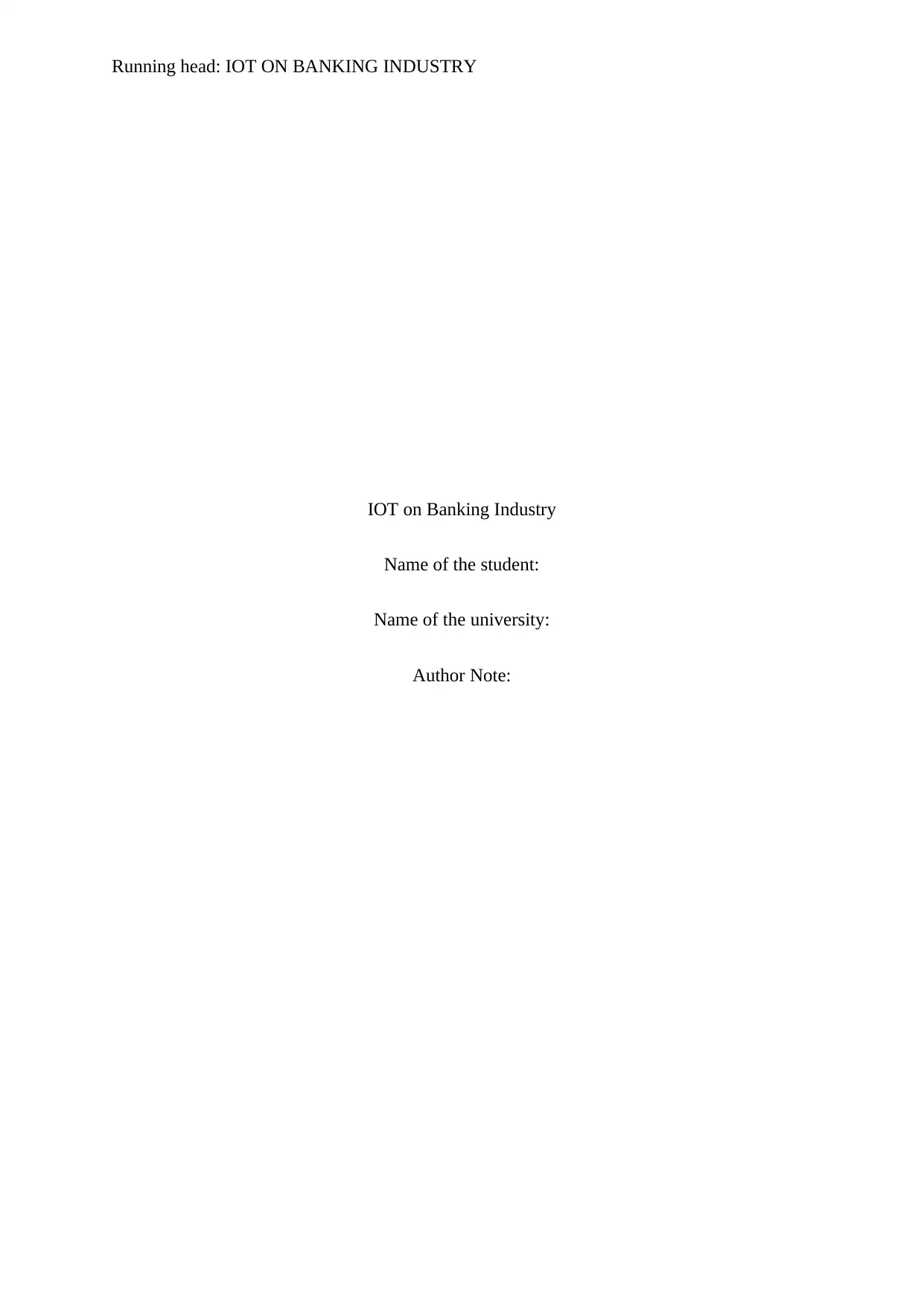
Running head: IOT ON BANKING INDUSTRY
IOT on Banking Industry
Name of the student:
Name of the university:
Author Note:
IOT on Banking Industry
Name of the student:
Name of the university:
Author Note:
Secure Best Marks with AI Grader
Need help grading? Try our AI Grader for instant feedback on your assignments.
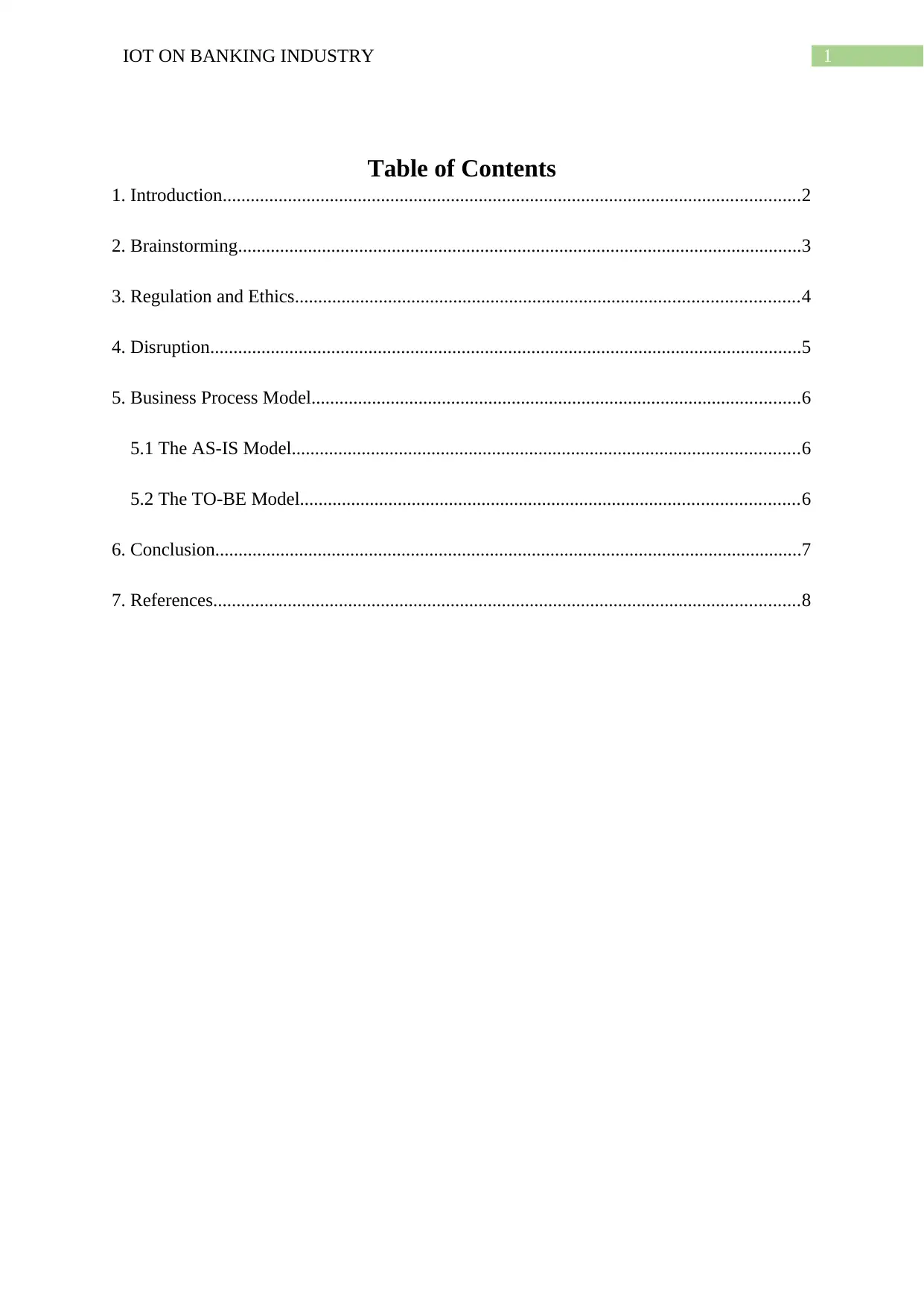
1IOT ON BANKING INDUSTRY
Table of Contents
1. Introduction............................................................................................................................2
2. Brainstorming.........................................................................................................................3
3. Regulation and Ethics............................................................................................................4
4. Disruption...............................................................................................................................5
5. Business Process Model.........................................................................................................6
5.1 The AS-IS Model.............................................................................................................6
5.2 The TO-BE Model...........................................................................................................6
6. Conclusion..............................................................................................................................7
7. References..............................................................................................................................8
Table of Contents
1. Introduction............................................................................................................................2
2. Brainstorming.........................................................................................................................3
3. Regulation and Ethics............................................................................................................4
4. Disruption...............................................................................................................................5
5. Business Process Model.........................................................................................................6
5.1 The AS-IS Model.............................................................................................................6
5.2 The TO-BE Model...........................................................................................................6
6. Conclusion..............................................................................................................................7
7. References..............................................................................................................................8
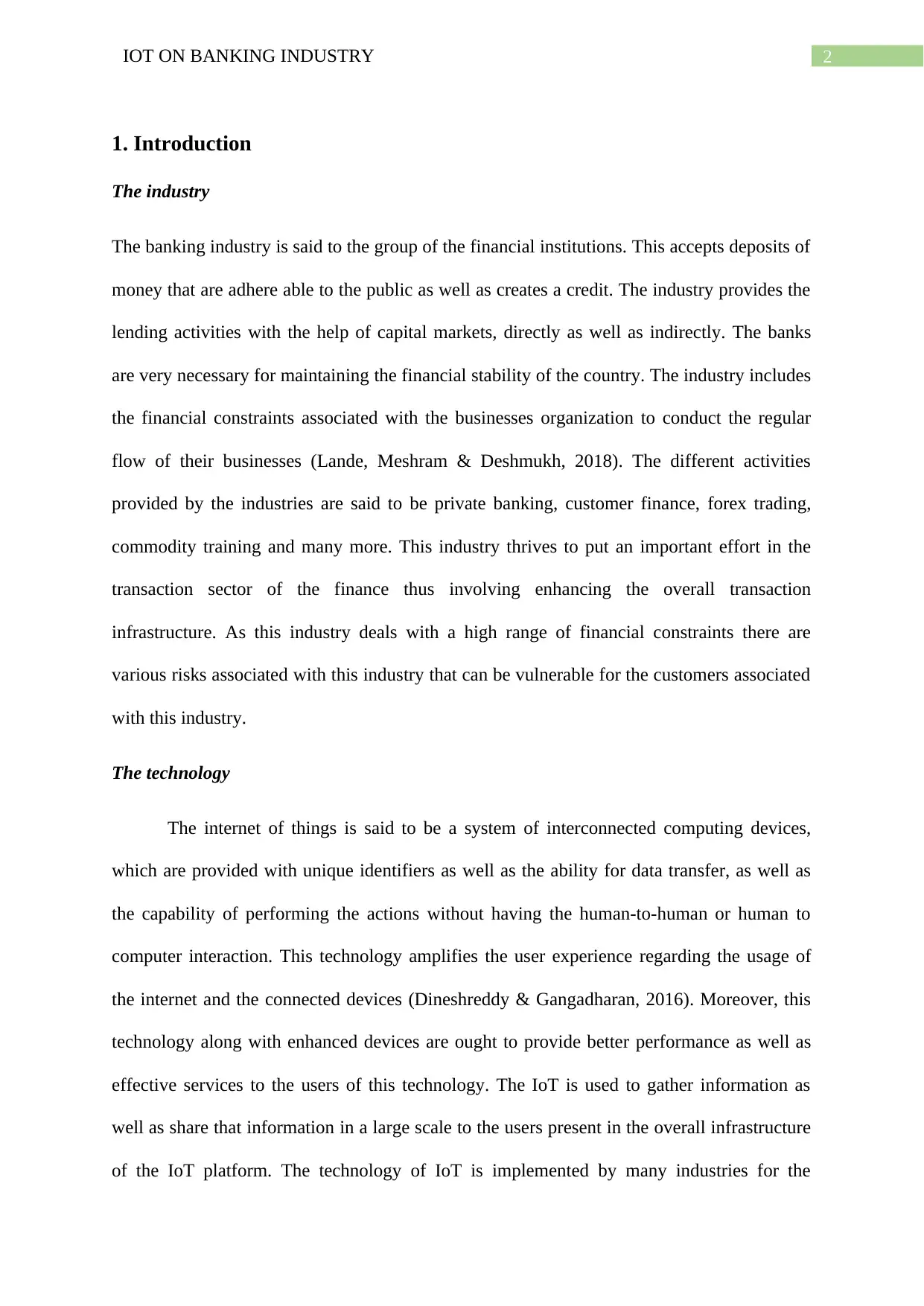
2IOT ON BANKING INDUSTRY
1. Introduction
The industry
The banking industry is said to the group of the financial institutions. This accepts deposits of
money that are adhere able to the public as well as creates a credit. The industry provides the
lending activities with the help of capital markets, directly as well as indirectly. The banks
are very necessary for maintaining the financial stability of the country. The industry includes
the financial constraints associated with the businesses organization to conduct the regular
flow of their businesses (Lande, Meshram & Deshmukh, 2018). The different activities
provided by the industries are said to be private banking, customer finance, forex trading,
commodity training and many more. This industry thrives to put an important effort in the
transaction sector of the finance thus involving enhancing the overall transaction
infrastructure. As this industry deals with a high range of financial constraints there are
various risks associated with this industry that can be vulnerable for the customers associated
with this industry.
The technology
The internet of things is said to be a system of interconnected computing devices,
which are provided with unique identifiers as well as the ability for data transfer, as well as
the capability of performing the actions without having the human-to-human or human to
computer interaction. This technology amplifies the user experience regarding the usage of
the internet and the connected devices (Dineshreddy & Gangadharan, 2016). Moreover, this
technology along with enhanced devices are ought to provide better performance as well as
effective services to the users of this technology. The IoT is used to gather information as
well as share that information in a large scale to the users present in the overall infrastructure
of the IoT platform. The technology of IoT is implemented by many industries for the
1. Introduction
The industry
The banking industry is said to the group of the financial institutions. This accepts deposits of
money that are adhere able to the public as well as creates a credit. The industry provides the
lending activities with the help of capital markets, directly as well as indirectly. The banks
are very necessary for maintaining the financial stability of the country. The industry includes
the financial constraints associated with the businesses organization to conduct the regular
flow of their businesses (Lande, Meshram & Deshmukh, 2018). The different activities
provided by the industries are said to be private banking, customer finance, forex trading,
commodity training and many more. This industry thrives to put an important effort in the
transaction sector of the finance thus involving enhancing the overall transaction
infrastructure. As this industry deals with a high range of financial constraints there are
various risks associated with this industry that can be vulnerable for the customers associated
with this industry.
The technology
The internet of things is said to be a system of interconnected computing devices,
which are provided with unique identifiers as well as the ability for data transfer, as well as
the capability of performing the actions without having the human-to-human or human to
computer interaction. This technology amplifies the user experience regarding the usage of
the internet and the connected devices (Dineshreddy & Gangadharan, 2016). Moreover, this
technology along with enhanced devices are ought to provide better performance as well as
effective services to the users of this technology. The IoT is used to gather information as
well as share that information in a large scale to the users present in the overall infrastructure
of the IoT platform. The technology of IoT is implemented by many industries for the
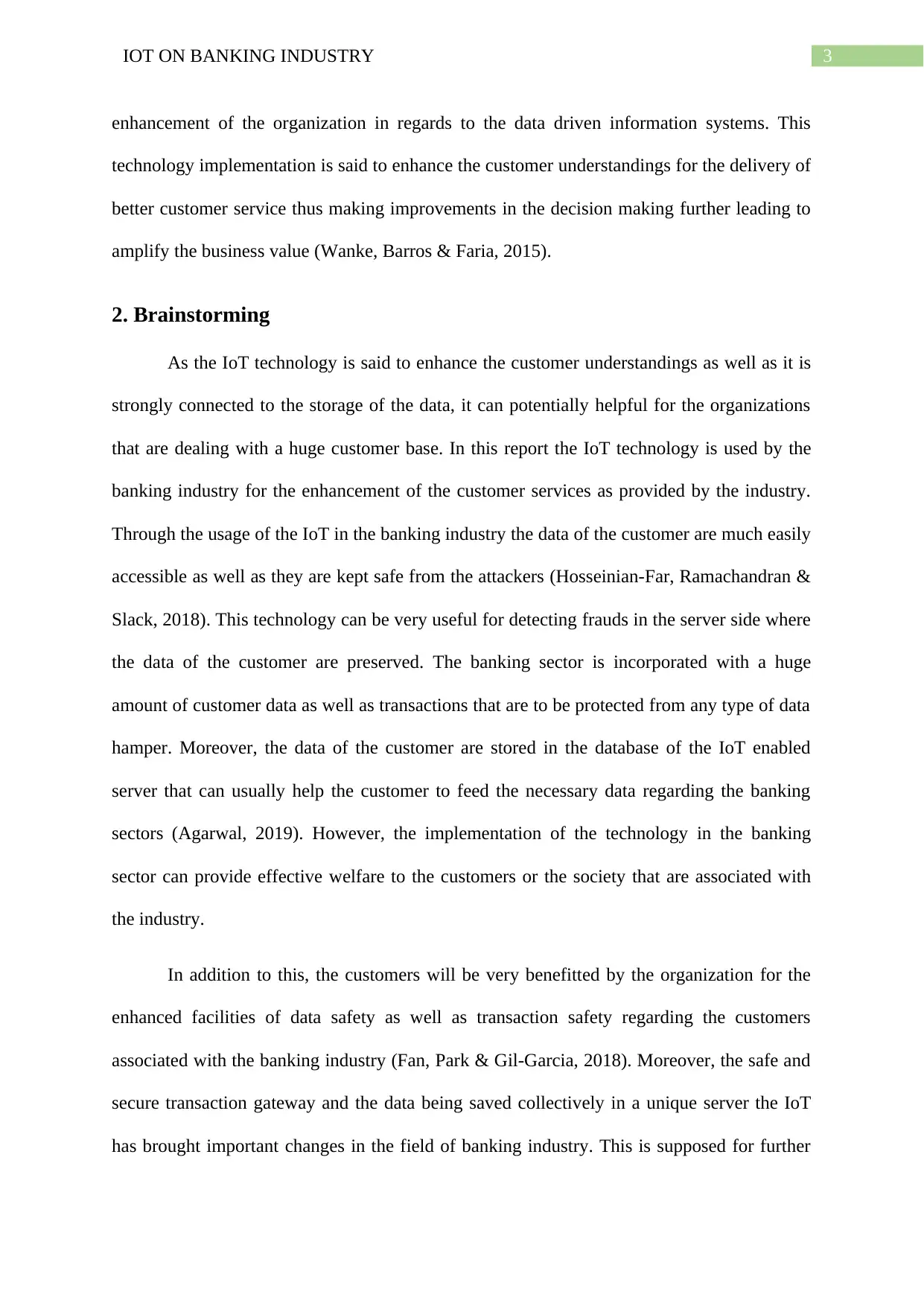
3IOT ON BANKING INDUSTRY
enhancement of the organization in regards to the data driven information systems. This
technology implementation is said to enhance the customer understandings for the delivery of
better customer service thus making improvements in the decision making further leading to
amplify the business value (Wanke, Barros & Faria, 2015).
2. Brainstorming
As the IoT technology is said to enhance the customer understandings as well as it is
strongly connected to the storage of the data, it can potentially helpful for the organizations
that are dealing with a huge customer base. In this report the IoT technology is used by the
banking industry for the enhancement of the customer services as provided by the industry.
Through the usage of the IoT in the banking industry the data of the customer are much easily
accessible as well as they are kept safe from the attackers (Hosseinian-Far, Ramachandran &
Slack, 2018). This technology can be very useful for detecting frauds in the server side where
the data of the customer are preserved. The banking sector is incorporated with a huge
amount of customer data as well as transactions that are to be protected from any type of data
hamper. Moreover, the data of the customer are stored in the database of the IoT enabled
server that can usually help the customer to feed the necessary data regarding the banking
sectors (Agarwal, 2019). However, the implementation of the technology in the banking
sector can provide effective welfare to the customers or the society that are associated with
the industry.
In addition to this, the customers will be very benefitted by the organization for the
enhanced facilities of data safety as well as transaction safety regarding the customers
associated with the banking industry (Fan, Park & Gil-Garcia, 2018). Moreover, the safe and
secure transaction gateway and the data being saved collectively in a unique server the IoT
has brought important changes in the field of banking industry. This is supposed for further
enhancement of the organization in regards to the data driven information systems. This
technology implementation is said to enhance the customer understandings for the delivery of
better customer service thus making improvements in the decision making further leading to
amplify the business value (Wanke, Barros & Faria, 2015).
2. Brainstorming
As the IoT technology is said to enhance the customer understandings as well as it is
strongly connected to the storage of the data, it can potentially helpful for the organizations
that are dealing with a huge customer base. In this report the IoT technology is used by the
banking industry for the enhancement of the customer services as provided by the industry.
Through the usage of the IoT in the banking industry the data of the customer are much easily
accessible as well as they are kept safe from the attackers (Hosseinian-Far, Ramachandran &
Slack, 2018). This technology can be very useful for detecting frauds in the server side where
the data of the customer are preserved. The banking sector is incorporated with a huge
amount of customer data as well as transactions that are to be protected from any type of data
hamper. Moreover, the data of the customer are stored in the database of the IoT enabled
server that can usually help the customer to feed the necessary data regarding the banking
sectors (Agarwal, 2019). However, the implementation of the technology in the banking
sector can provide effective welfare to the customers or the society that are associated with
the industry.
In addition to this, the customers will be very benefitted by the organization for the
enhanced facilities of data safety as well as transaction safety regarding the customers
associated with the banking industry (Fan, Park & Gil-Garcia, 2018). Moreover, the safe and
secure transaction gateway and the data being saved collectively in a unique server the IoT
has brought important changes in the field of banking industry. This is supposed for further
Secure Best Marks with AI Grader
Need help grading? Try our AI Grader for instant feedback on your assignments.

4IOT ON BANKING INDUSTRY
enhancing the data usability by the organization as well as with the secure transaction
gateway, it can provide effective services to the customers. The technology has also put an
impact in the customer usability by the enhancing the IoT services for the senior citizens that
they can use the banking services via the usage of mobile applications, that will provide ease
of access to the customers who are willing to take the banking services from the industry
(Patil & Dharwadkar, 2017).
3. Regulation and Ethics
From the analysis of the above study it can be explained that the security factors
associated with this technology implementation may put a positive impact in the industry of
banking. As safety of data is not under control by the technology, it can be identified as a
serious issue in the industry of banking (Japparova & Rupeika-Apoga, 2017). Four factors are
depicted as the important constraints for the technological changes in the environment of the
mentioned industry are framed in accordance to Lawrence Lessig’s regulations. These are
explained below:
Architecture: The overall infrastructure as well as design of the banking industry
must be structured in a smooth manner that the access of this infrastructure is
enhanced by the employees of the organization as well as the persons that are trying
to use the services provided from the industry . The automation of availing the
banking services and the smooth access of the data for the overall procedure in the
banking sectors has put an effective growth of the industry.
Market: the strategies of marketing the different schemes as well as providing more
information about a bank are said to be the marketing strategies that can be provided
by the IoT implementation in the environment of the banking sectors (VimalJerald,
Rabara & Bai, 2015).
enhancing the data usability by the organization as well as with the secure transaction
gateway, it can provide effective services to the customers. The technology has also put an
impact in the customer usability by the enhancing the IoT services for the senior citizens that
they can use the banking services via the usage of mobile applications, that will provide ease
of access to the customers who are willing to take the banking services from the industry
(Patil & Dharwadkar, 2017).
3. Regulation and Ethics
From the analysis of the above study it can be explained that the security factors
associated with this technology implementation may put a positive impact in the industry of
banking. As safety of data is not under control by the technology, it can be identified as a
serious issue in the industry of banking (Japparova & Rupeika-Apoga, 2017). Four factors are
depicted as the important constraints for the technological changes in the environment of the
mentioned industry are framed in accordance to Lawrence Lessig’s regulations. These are
explained below:
Architecture: The overall infrastructure as well as design of the banking industry
must be structured in a smooth manner that the access of this infrastructure is
enhanced by the employees of the organization as well as the persons that are trying
to use the services provided from the industry . The automation of availing the
banking services and the smooth access of the data for the overall procedure in the
banking sectors has put an effective growth of the industry.
Market: the strategies of marketing the different schemes as well as providing more
information about a bank are said to be the marketing strategies that can be provided
by the IoT implementation in the environment of the banking sectors (VimalJerald,
Rabara & Bai, 2015).
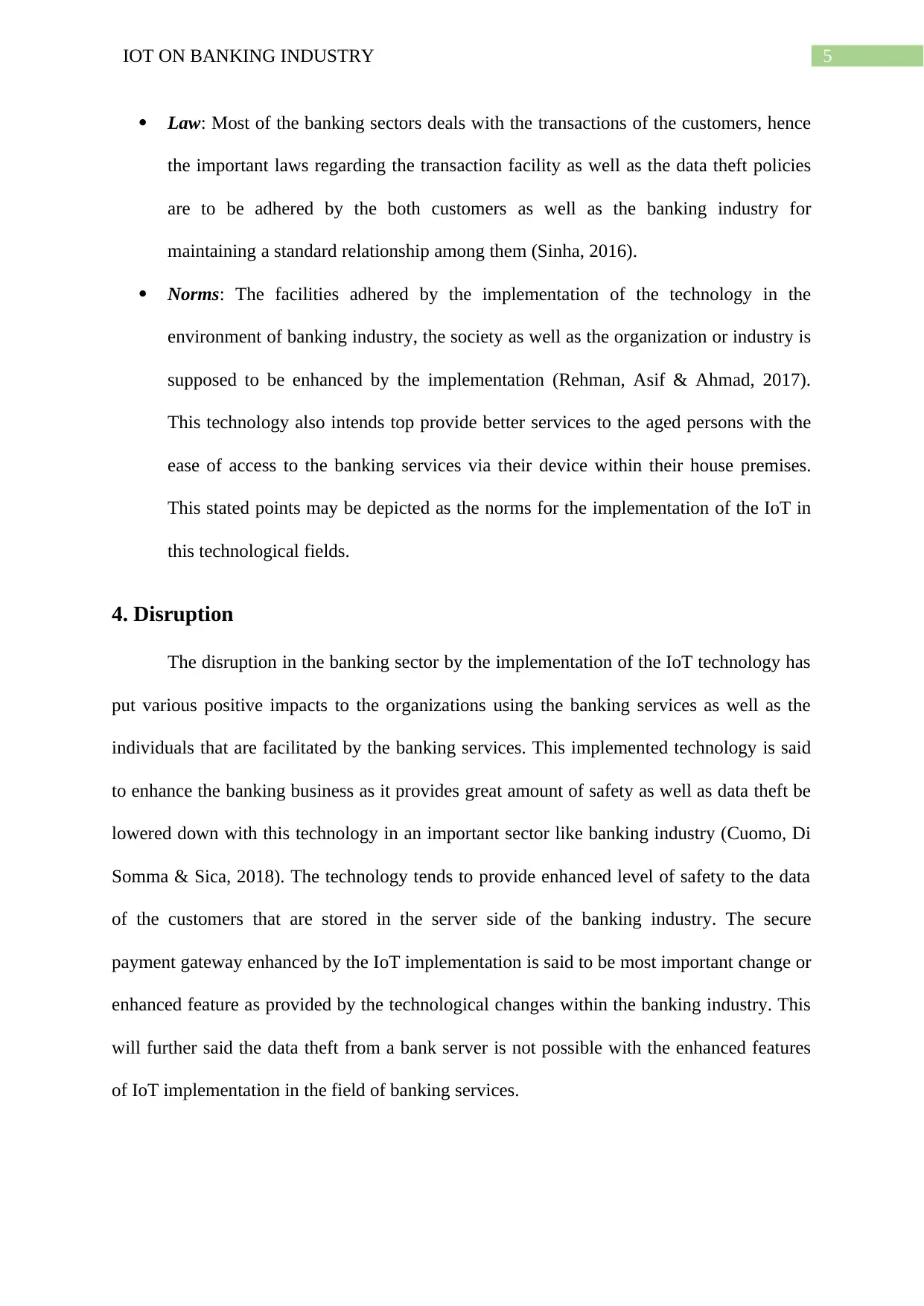
5IOT ON BANKING INDUSTRY
Law: Most of the banking sectors deals with the transactions of the customers, hence
the important laws regarding the transaction facility as well as the data theft policies
are to be adhered by the both customers as well as the banking industry for
maintaining a standard relationship among them (Sinha, 2016).
Norms: The facilities adhered by the implementation of the technology in the
environment of banking industry, the society as well as the organization or industry is
supposed to be enhanced by the implementation (Rehman, Asif & Ahmad, 2017).
This technology also intends top provide better services to the aged persons with the
ease of access to the banking services via their device within their house premises.
This stated points may be depicted as the norms for the implementation of the IoT in
this technological fields.
4. Disruption
The disruption in the banking sector by the implementation of the IoT technology has
put various positive impacts to the organizations using the banking services as well as the
individuals that are facilitated by the banking services. This implemented technology is said
to enhance the banking business as it provides great amount of safety as well as data theft be
lowered down with this technology in an important sector like banking industry (Cuomo, Di
Somma & Sica, 2018). The technology tends to provide enhanced level of safety to the data
of the customers that are stored in the server side of the banking industry. The secure
payment gateway enhanced by the IoT implementation is said to be most important change or
enhanced feature as provided by the technological changes within the banking industry. This
will further said the data theft from a bank server is not possible with the enhanced features
of IoT implementation in the field of banking services.
Law: Most of the banking sectors deals with the transactions of the customers, hence
the important laws regarding the transaction facility as well as the data theft policies
are to be adhered by the both customers as well as the banking industry for
maintaining a standard relationship among them (Sinha, 2016).
Norms: The facilities adhered by the implementation of the technology in the
environment of banking industry, the society as well as the organization or industry is
supposed to be enhanced by the implementation (Rehman, Asif & Ahmad, 2017).
This technology also intends top provide better services to the aged persons with the
ease of access to the banking services via their device within their house premises.
This stated points may be depicted as the norms for the implementation of the IoT in
this technological fields.
4. Disruption
The disruption in the banking sector by the implementation of the IoT technology has
put various positive impacts to the organizations using the banking services as well as the
individuals that are facilitated by the banking services. This implemented technology is said
to enhance the banking business as it provides great amount of safety as well as data theft be
lowered down with this technology in an important sector like banking industry (Cuomo, Di
Somma & Sica, 2018). The technology tends to provide enhanced level of safety to the data
of the customers that are stored in the server side of the banking industry. The secure
payment gateway enhanced by the IoT implementation is said to be most important change or
enhanced feature as provided by the technological changes within the banking industry. This
will further said the data theft from a bank server is not possible with the enhanced features
of IoT implementation in the field of banking services.
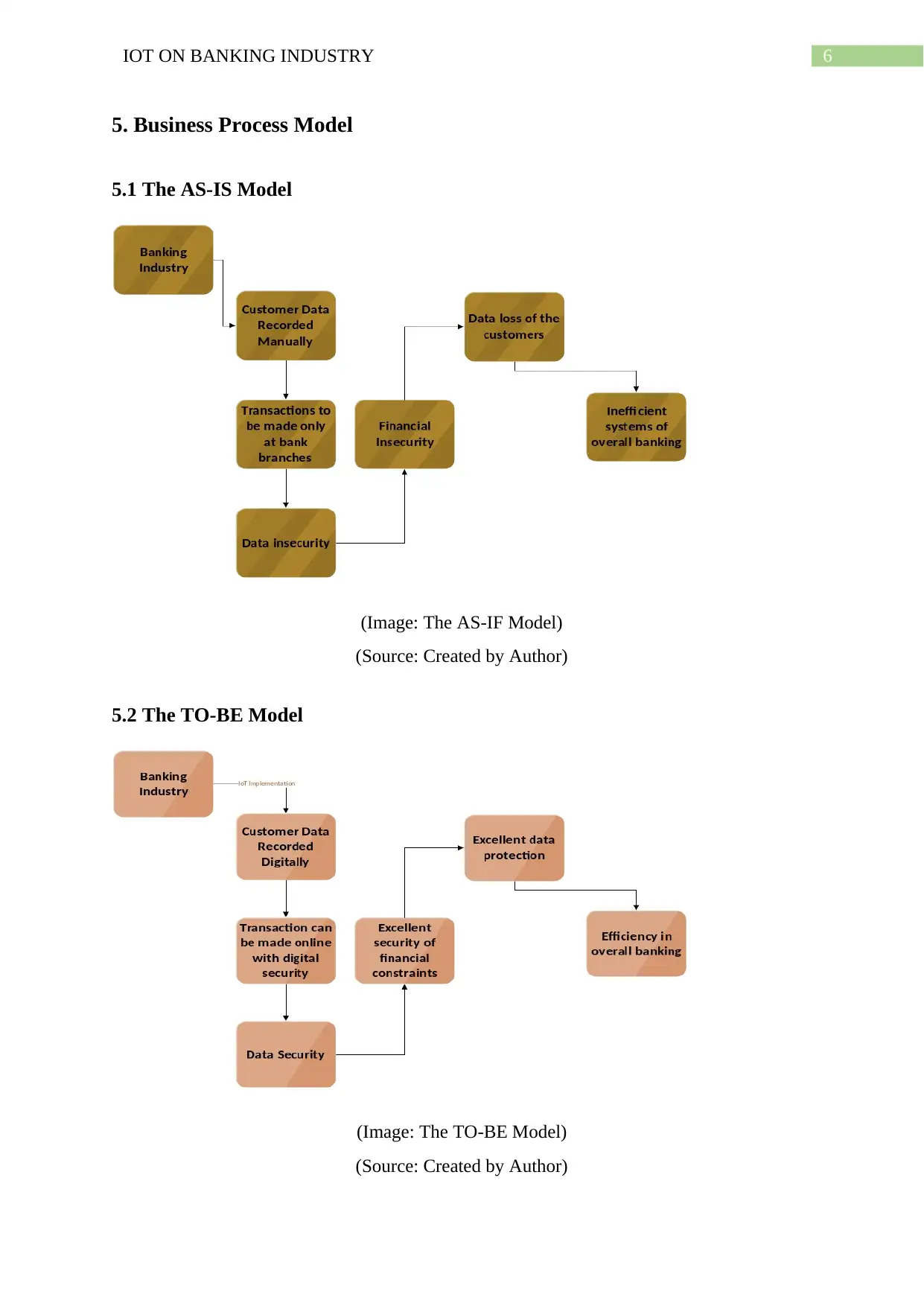
6IOT ON BANKING INDUSTRY
5. Business Process Model
5.1 The AS-IS Model
(Image: The AS-IF Model)
(Source: Created by Author)
5.2 The TO-BE Model
(Image: The TO-BE Model)
(Source: Created by Author)
5. Business Process Model
5.1 The AS-IS Model
(Image: The AS-IF Model)
(Source: Created by Author)
5.2 The TO-BE Model
(Image: The TO-BE Model)
(Source: Created by Author)
Paraphrase This Document
Need a fresh take? Get an instant paraphrase of this document with our AI Paraphraser
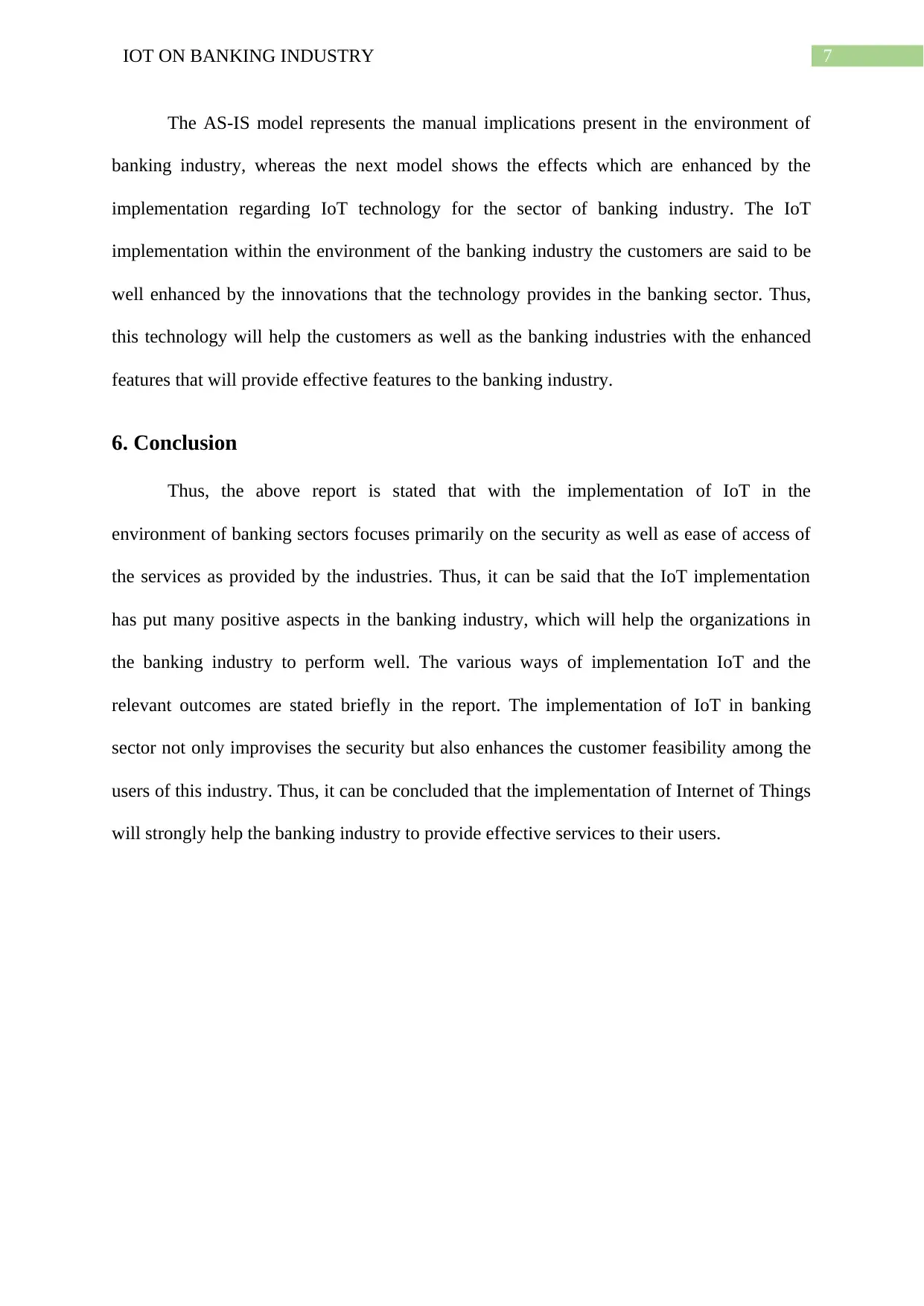
7IOT ON BANKING INDUSTRY
The AS-IS model represents the manual implications present in the environment of
banking industry, whereas the next model shows the effects which are enhanced by the
implementation regarding IoT technology for the sector of banking industry. The IoT
implementation within the environment of the banking industry the customers are said to be
well enhanced by the innovations that the technology provides in the banking sector. Thus,
this technology will help the customers as well as the banking industries with the enhanced
features that will provide effective features to the banking industry.
6. Conclusion
Thus, the above report is stated that with the implementation of IoT in the
environment of banking sectors focuses primarily on the security as well as ease of access of
the services as provided by the industries. Thus, it can be said that the IoT implementation
has put many positive aspects in the banking industry, which will help the organizations in
the banking industry to perform well. The various ways of implementation IoT and the
relevant outcomes are stated briefly in the report. The implementation of IoT in banking
sector not only improvises the security but also enhances the customer feasibility among the
users of this industry. Thus, it can be concluded that the implementation of Internet of Things
will strongly help the banking industry to provide effective services to their users.
The AS-IS model represents the manual implications present in the environment of
banking industry, whereas the next model shows the effects which are enhanced by the
implementation regarding IoT technology for the sector of banking industry. The IoT
implementation within the environment of the banking industry the customers are said to be
well enhanced by the innovations that the technology provides in the banking sector. Thus,
this technology will help the customers as well as the banking industries with the enhanced
features that will provide effective features to the banking industry.
6. Conclusion
Thus, the above report is stated that with the implementation of IoT in the
environment of banking sectors focuses primarily on the security as well as ease of access of
the services as provided by the industries. Thus, it can be said that the IoT implementation
has put many positive aspects in the banking industry, which will help the organizations in
the banking industry to perform well. The various ways of implementation IoT and the
relevant outcomes are stated briefly in the report. The implementation of IoT in banking
sector not only improvises the security but also enhances the customer feasibility among the
users of this industry. Thus, it can be concluded that the implementation of Internet of Things
will strongly help the banking industry to provide effective services to their users.
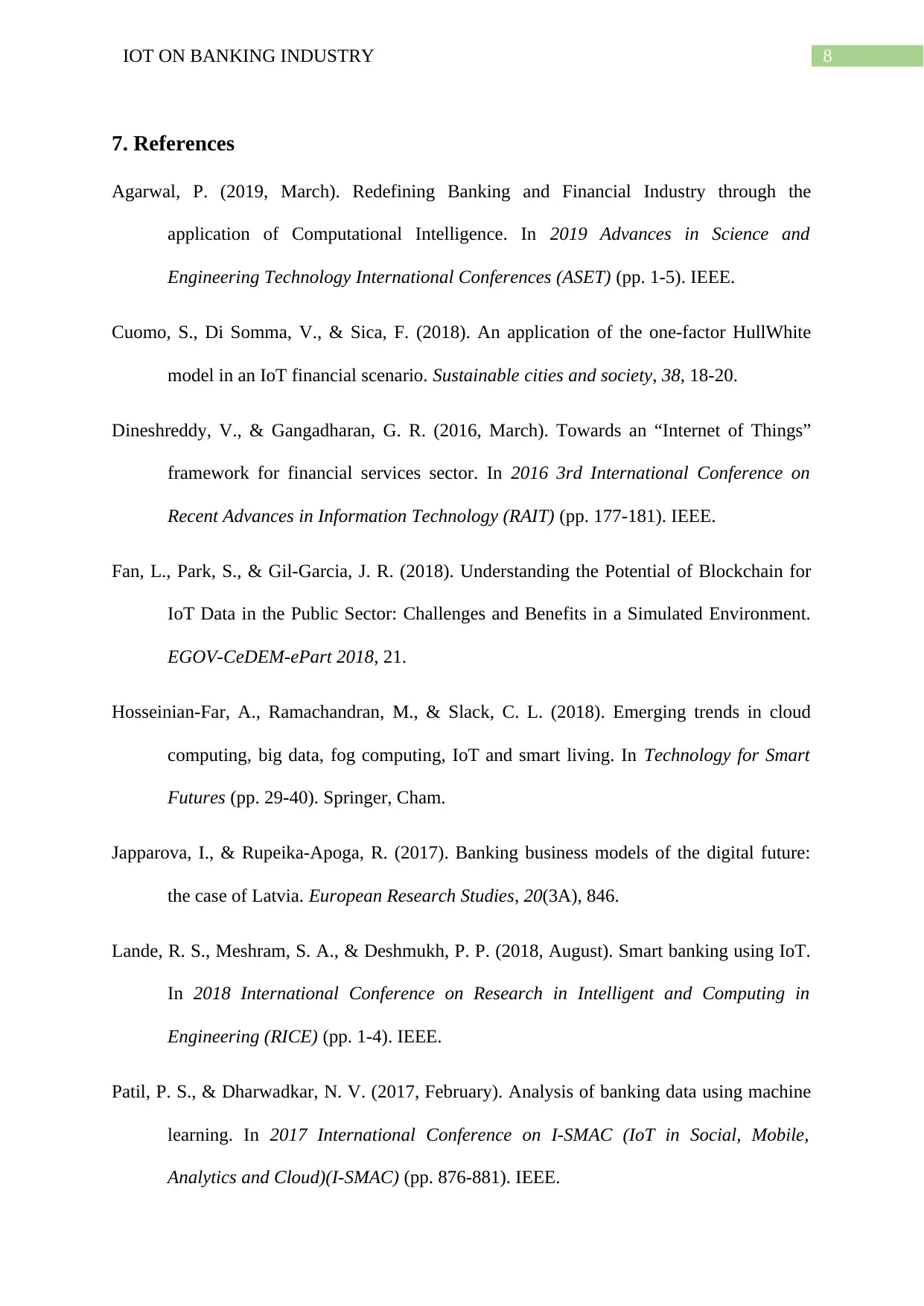
8IOT ON BANKING INDUSTRY
7. References
Agarwal, P. (2019, March). Redefining Banking and Financial Industry through the
application of Computational Intelligence. In 2019 Advances in Science and
Engineering Technology International Conferences (ASET) (pp. 1-5). IEEE.
Cuomo, S., Di Somma, V., & Sica, F. (2018). An application of the one-factor HullWhite
model in an IoT financial scenario. Sustainable cities and society, 38, 18-20.
Dineshreddy, V., & Gangadharan, G. R. (2016, March). Towards an “Internet of Things”
framework for financial services sector. In 2016 3rd International Conference on
Recent Advances in Information Technology (RAIT) (pp. 177-181). IEEE.
Fan, L., Park, S., & Gil-Garcia, J. R. (2018). Understanding the Potential of Blockchain for
IoT Data in the Public Sector: Challenges and Benefits in a Simulated Environment.
EGOV-CeDEM-ePart 2018, 21.
Hosseinian-Far, A., Ramachandran, M., & Slack, C. L. (2018). Emerging trends in cloud
computing, big data, fog computing, IoT and smart living. In Technology for Smart
Futures (pp. 29-40). Springer, Cham.
Japparova, I., & Rupeika-Apoga, R. (2017). Banking business models of the digital future:
the case of Latvia. European Research Studies, 20(3A), 846.
Lande, R. S., Meshram, S. A., & Deshmukh, P. P. (2018, August). Smart banking using IoT.
In 2018 International Conference on Research in Intelligent and Computing in
Engineering (RICE) (pp. 1-4). IEEE.
Patil, P. S., & Dharwadkar, N. V. (2017, February). Analysis of banking data using machine
learning. In 2017 International Conference on I-SMAC (IoT in Social, Mobile,
Analytics and Cloud)(I-SMAC) (pp. 876-881). IEEE.
7. References
Agarwal, P. (2019, March). Redefining Banking and Financial Industry through the
application of Computational Intelligence. In 2019 Advances in Science and
Engineering Technology International Conferences (ASET) (pp. 1-5). IEEE.
Cuomo, S., Di Somma, V., & Sica, F. (2018). An application of the one-factor HullWhite
model in an IoT financial scenario. Sustainable cities and society, 38, 18-20.
Dineshreddy, V., & Gangadharan, G. R. (2016, March). Towards an “Internet of Things”
framework for financial services sector. In 2016 3rd International Conference on
Recent Advances in Information Technology (RAIT) (pp. 177-181). IEEE.
Fan, L., Park, S., & Gil-Garcia, J. R. (2018). Understanding the Potential of Blockchain for
IoT Data in the Public Sector: Challenges and Benefits in a Simulated Environment.
EGOV-CeDEM-ePart 2018, 21.
Hosseinian-Far, A., Ramachandran, M., & Slack, C. L. (2018). Emerging trends in cloud
computing, big data, fog computing, IoT and smart living. In Technology for Smart
Futures (pp. 29-40). Springer, Cham.
Japparova, I., & Rupeika-Apoga, R. (2017). Banking business models of the digital future:
the case of Latvia. European Research Studies, 20(3A), 846.
Lande, R. S., Meshram, S. A., & Deshmukh, P. P. (2018, August). Smart banking using IoT.
In 2018 International Conference on Research in Intelligent and Computing in
Engineering (RICE) (pp. 1-4). IEEE.
Patil, P. S., & Dharwadkar, N. V. (2017, February). Analysis of banking data using machine
learning. In 2017 International Conference on I-SMAC (IoT in Social, Mobile,
Analytics and Cloud)(I-SMAC) (pp. 876-881). IEEE.
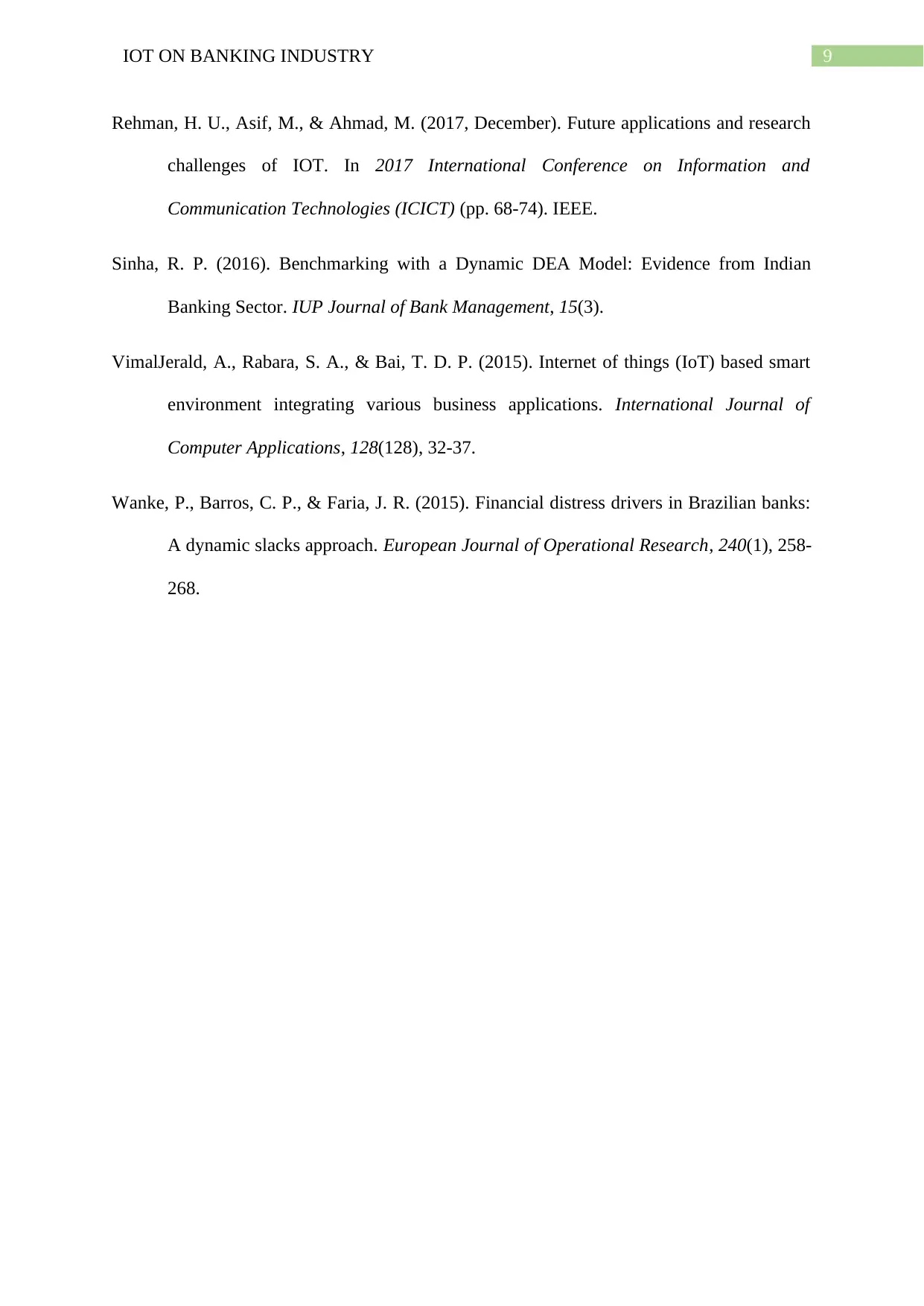
9IOT ON BANKING INDUSTRY
Rehman, H. U., Asif, M., & Ahmad, M. (2017, December). Future applications and research
challenges of IOT. In 2017 International Conference on Information and
Communication Technologies (ICICT) (pp. 68-74). IEEE.
Sinha, R. P. (2016). Benchmarking with a Dynamic DEA Model: Evidence from Indian
Banking Sector. IUP Journal of Bank Management, 15(3).
VimalJerald, A., Rabara, S. A., & Bai, T. D. P. (2015). Internet of things (IoT) based smart
environment integrating various business applications. International Journal of
Computer Applications, 128(128), 32-37.
Wanke, P., Barros, C. P., & Faria, J. R. (2015). Financial distress drivers in Brazilian banks:
A dynamic slacks approach. European Journal of Operational Research, 240(1), 258-
268.
Rehman, H. U., Asif, M., & Ahmad, M. (2017, December). Future applications and research
challenges of IOT. In 2017 International Conference on Information and
Communication Technologies (ICICT) (pp. 68-74). IEEE.
Sinha, R. P. (2016). Benchmarking with a Dynamic DEA Model: Evidence from Indian
Banking Sector. IUP Journal of Bank Management, 15(3).
VimalJerald, A., Rabara, S. A., & Bai, T. D. P. (2015). Internet of things (IoT) based smart
environment integrating various business applications. International Journal of
Computer Applications, 128(128), 32-37.
Wanke, P., Barros, C. P., & Faria, J. R. (2015). Financial distress drivers in Brazilian banks:
A dynamic slacks approach. European Journal of Operational Research, 240(1), 258-
268.
1 out of 10
Related Documents
Your All-in-One AI-Powered Toolkit for Academic Success.
+13062052269
info@desklib.com
Available 24*7 on WhatsApp / Email
![[object Object]](/_next/static/media/star-bottom.7253800d.svg)
Unlock your academic potential
© 2024 | Zucol Services PVT LTD | All rights reserved.





